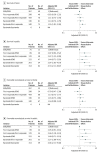Association of Public Health Initiatives With Outcomes for Out-of-Hospital Cardiac Arrest at Home and in Public Locations
- PMID: 28979980
- PMCID: PMC5710360
- DOI: 10.1001/jamacardio.2017.3471
Association of Public Health Initiatives With Outcomes for Out-of-Hospital Cardiac Arrest at Home and in Public Locations
Abstract
Importance: Little is known about the influence of comprehensive public health initiatives according to out-of-hospital cardiac arrest (OHCA) location, particularly at home, where resuscitation efforts and outcomes have historically been poor.
Objective: To describe temporal trends in bystander cardiopulmonary resuscitation (CPR) and first-responder defibrillation for OHCAs stratified by home vs public location and their association with survival and neurological outcomes.
Design, setting, and participants: This observational study reviewed 8269 patients with OHCAs (5602 [67.7%] at home and 2667 [32.3%] in public) for whom resuscitation was attempted using data from the Cardiac Arrest Registry to Enhance Survival (CARES) from January 1, 2010, through December 31, 2014. The setting was 16 counties in North Carolina.
Exposures: Patients were stratified by home vs public OHCA. Public health initiatives to improve bystander and first-responder interventions included training members of the general population in CPR and in the use of automated external defibrillators, teaching first responders about team-based CPR (eg, automated external defibrillator use and high-performance CPR), and instructing dispatch centers on recognition of cardiac arrest.
Main outcomes and measures: Association of resuscitation efforts with survival and neurological outcomes from 2010 through 2014.
Results: Among home OHCA patients (n = 5602), the median age was 64 years, and 62.2% were male; among public OHCA patients (n = 2667), the median age was 68 years, and 61.5% were male. After comprehensive public health initiatives, the proportion of patients receiving bystander CPR increased at home (from 28.3% [275 of 973] to 41.3% [498 of 1206], P < .001) and in public (from 61.0% [275 of 451] to 70.5% [424 of 601], P = .01), while first-responder defibrillation increased at home (from 42.2% [132 of 313] to 50.8% [212 of 417], P = .02) but not significantly in public (from 33.1% [58 of 175] to 37.8% [93 of 246], P = .17). Survival to discharge improved for arrests at home (from 5.7% [60 of 1057] to 8.1% [100 of 1238], P = .047) and in public (from 10.8% [50 of 464] to 16.2% [98 of 604], P = .04). Compared with emergency medical services-initiated CPR and resuscitation, patients with home OHCA were significantly more likely to survive to hospital discharge if they received bystander-initiated CPR and first-responder defibrillation (odds ratio, 1.55; 95% CI, 1.01-2.38). Patients with arrests in public were most likely to survive if they received both bystander-initiated CPR and defibrillation (odds ratio, 4.33; 95% CI, 2.11-8.87).
Conclusions and relevance: After coordinated and comprehensive public health initiatives, more patients received bystander CPR and first-responder defibrillation at home and in public, which was associated with improved survival.
Conflict of interest statement
Figures



Comment in
-
Improving Outcomes After Out-of-Hospital Cardiac Arrest.JAMA Cardiol. 2017 Nov 1;2(11):1183-1184. doi: 10.1001/jamacardio.2017.3472. JAMA Cardiol. 2017. PMID: 28979976 No abstract available.
References
-
- Mozaffarian D, Benjamin EJ, Go AS, et al. ; Writing Group Members; American Heart Association Statistics Committee; Stroke Statistics Subcommittee . Heart disease and stroke statistics: 2016 update: a report from the American Heart Association. Circulation. 2016;133(4):e38-e360. - PubMed
-
- Folke F, Gislason GH, Lippert FK, et al. . Differences between out-of-hospital cardiac arrest in residential and public locations and implications for public-access defibrillation. Circulation. 2010;122(6):623-630. - PubMed
-
- Iwami T, Hiraide A, Nakanishi N, et al. . Outcome and characteristics of out-of-hospital cardiac arrest according to location of arrest: a report from a large-scale, population-based study in Osaka, Japan. Resuscitation. 2006;69(2):221-228. - PubMed
-
- Hulleman M, Zijlstra JA, Beesems SG, et al. . Causes for the declining proportion of ventricular fibrillation in out-of-hospital cardiac arrest. Resuscitation. 2015;96:23-29. - PubMed
Publication types
MeSH terms
LinkOut - more resources
Full Text Sources
Other Literature Sources
Medical

